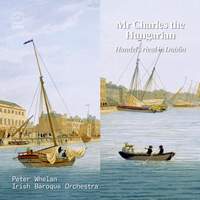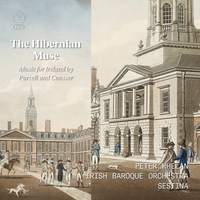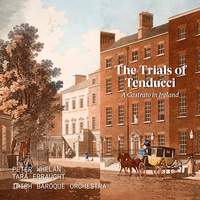Recording of the Week,
A Grand Concert of Music by Mr Charles, the Hungarian (lately arriv'd from Paris)

Today’s recording of the week comes from Peter Whelan and the Irish Baroque Orchestra, who continue their exploration of the music scene of Baroque Dublin with an album devoted to the mysterious “Mr Charles the Hungarian”. Although this shadowy individual might sound like a supporting character in a British crime caper (perhaps played by, or pitted against, Vinnie Jones), he seems in reality to have been a man called Carlo Vernsberg – a talented horn player and composer, as well as a sharp-eyed impresario with a real gift for serving up musical novelty to the curious audiences of the time.
"The Clarinet, the Hautbois de Amour, and Shalamo, were never heard in this Kingdom before."
Vernsberg's concerts in Dublin promised audiences new sonic experiences – instruments they had never heard before, such as the clarinet (then a new invention), oboe d’amore and chalumeau. The combination of novelty, virtuosity and a well-honed sense for musical trends made them highly successful. One such concert, held in the Smock Alley Theatre in May 1742 and featuring the hugely fashionable music of Handel – while the composer himself was in town following the premiere of Messiah! – forms the basis of this album, and perhaps also gives us an insight into Vernsberg’s cheekily entrepreneurial mindset.
While much of the music for these concerts did not survive – a casualty of that taste for the new, limiting interest in preserving it for posterity – Whelan and his musicians have assembled a kind of semi-reenactment, capturing something of what might have been heard. The overture to Handel’s Il pastor fido raises the curtain with a hint of what is to come, featuring the horns prominently. The real fireworks begin, though, when Anneke Scott stands up for her obbligato in Va tacito from Giulio Cesare – with the vocal part here given to the flute, the horn is absolutely centre stage and Scott doesn’t hold back. In the da capo her ornamentation is particularly adventurous – freed of the need to balance a singer, she darts about the instrument’s range with amazing agility.
A wind trio by any other name
The wind instruments really do rule the roost on this album – though I would encourage any string devotees who are feeling short-changed to be patient, as there is a real treat waiting towards the end. The purported “chalumeau concerto” by Hasse is really more of a chamber piece, with the oboe and bassoon just as important in the texture and the continuo very much in the background. The slow movement is especially beautiful, though I would be remiss if I didn’t single out bassoonist Michele Fattori for his wonderfully light-footed triplets in the closing Allegretto.
Even in an age where audiences seem to have been insatiably hungry for new music, it would be a foolish concert-organiser who didn’t include a few well-known hits on the programme, and among them are some selections from Handel’s Water Music suites – with the twist that the trumpet parts are here taken by oboe and clarinet. The effect of this is fairly subtle in the F major suite, but in the two movements from the D major suite it’s much more audible. The horns, of course, are as energetic and boisterous as ever, which creates a very effective contrast that would otherwise not be so apparent.
So, what about the strings? Well, they don’t go home empty-handed. The bustling Sonata No. 10 by Lorenzo Bocchi (about whom very little seems to be known, even his dates) sees cellist Jonathan Byers step out of the continuo section and into the limelight. It’s a brief work, but full of contrasts that Byers embraces wholeheartedly – a vigorous opening movement, a central Adagio filled with almost melodramatic grief, and a closing Vivace where that grief seems to resolve into something verging on anger.
A brief calling-card from Mr Charles himself
Amidst all this, one might well ask: Where is Vernsberg's own music? Sadly very little of it has come down to us, but he is represented here by a lively hunting-style “chasse” from his set of twelve duos for horns – quite possibly written for him to perform alongside his wife, who is recorded as having been an accomplished player in her own right.
There’s a lot of music packed into this album – opera highlights, instrumental hits, concertos, sonatas and duos, all rounded off with a delightfully pompous Lully march in the faux-Turkish style. It’s exactly the kind of lively, varied programming that Vernsberg was so commercially successful with in the 1740s, and Whelan’s thoughtful reconstructive efforts are well worth a listen.
Irish Baroque Orchestra, Peter Whelan
Available Formats: CD, MP3, FLAC, Hi-Res FLAC, Hi-Res+ FLAC
Irish Baroque Orchestra, Sestina, Peter Whelan
Available Formats: CD, MP3, FLAC, Hi-Res FLAC
Tara Erraught (mezzo-soprano), Irish Baroque Orchestra, Peter Whelan
Available Formats: CD, MP3, FLAC, Hi-Res FLAC
Irish Baroque Orchestra, Peter Whelan
Available Formats: CD, MP3, FLAC, Hi-Res FLAC






